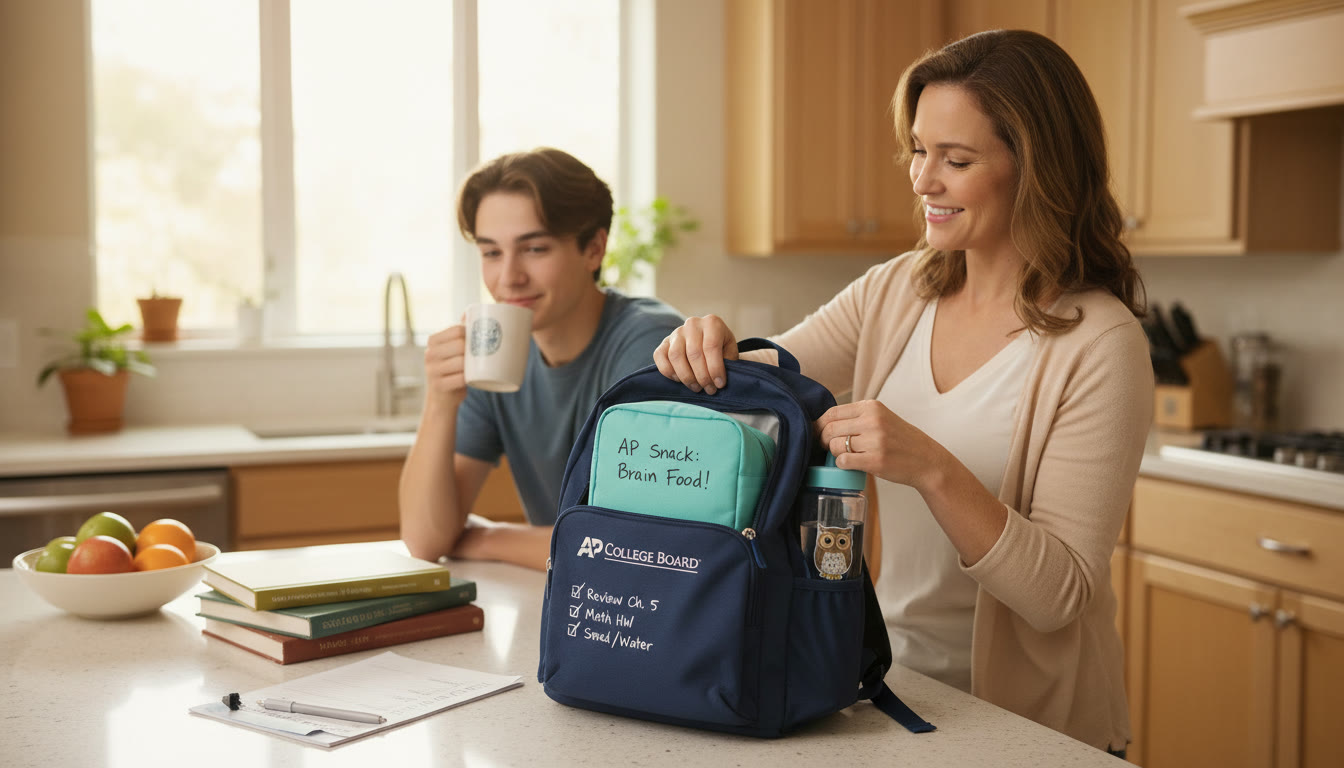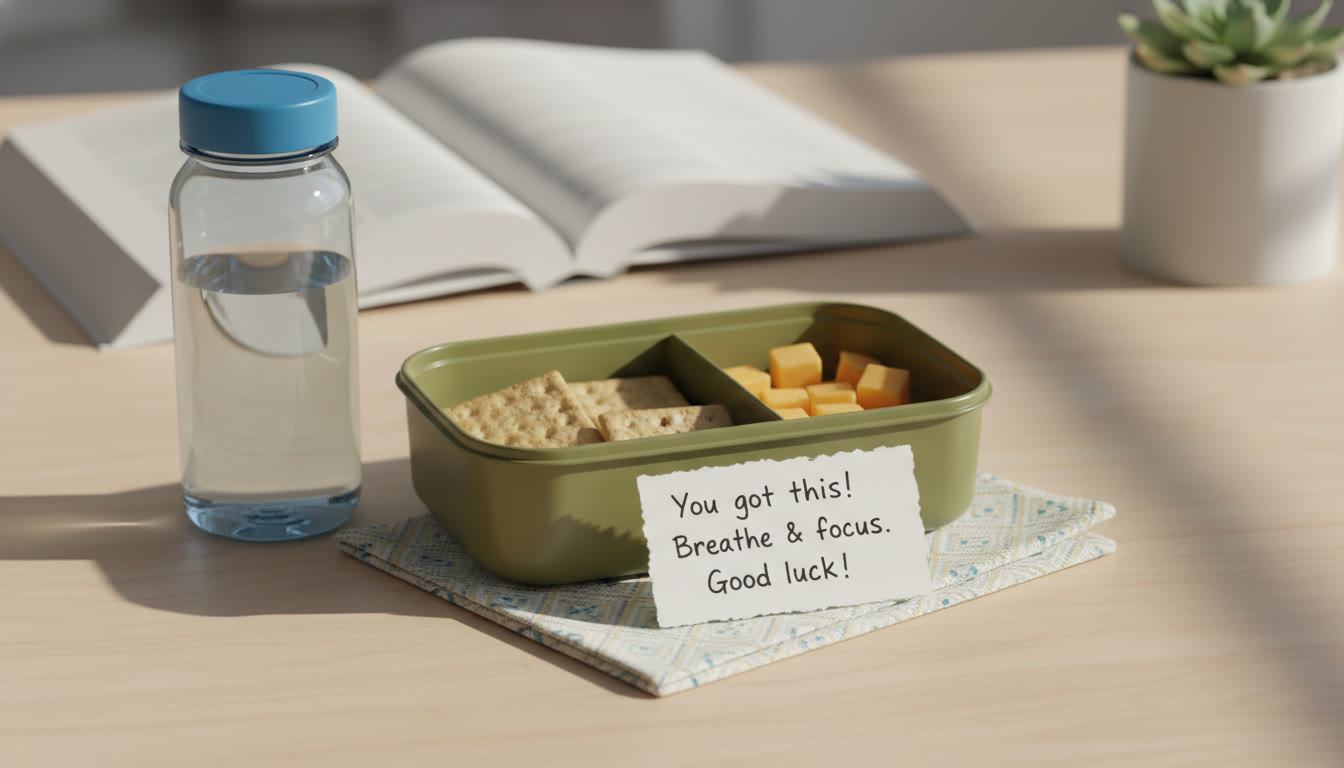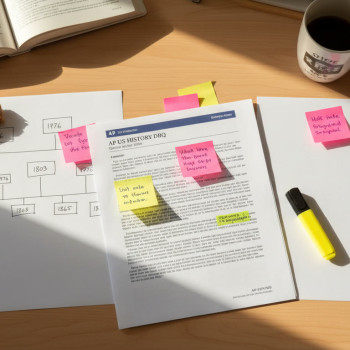Why Food and Hydration Matter on AP Exam Days
As a parent, you want your child to walk into an AP exam calm, confident, and performing at their best. You’ve helped with practice tests, encouraged good study rhythms, and maybe even arranged a few tutoring sessions (Sparkl’s personalized tutoring can be a helpful stitch in that safety net). But one thing many families underestimate is the power of what goes into your teen’s body in the 24 hours before—and the morning of—the exam.
Food and hydration do more than keep hunger at bay. They influence attention, working memory, processing speed, and mood. On long exam days, when students are tested for hours with only short breaks, having the right fueling strategy is like giving them an exam-day advantage that doesn’t show on the score report but absolutely shows in performance.
How Exams Tax the Body and Brain
Think about a long AP exam as a marathon for the brain. Sustained concentration, mental flexibility, and stress regulation all take energy. Blood glucose provides fuel for neurons; electrolytes and fluids maintain cellular function; and a calm nervous system is less likely to fall prey to anxiety that can derail recall or problem-solving. When any of these elements are out of balance, cognitive performance slips.
Key physiological stressors during long exams include:
- Fluctuating blood sugar from long stretches without food;
- Dehydration from not drinking enough (classrooms can be dry);
- Stress-driven digestion changes—some students eat less or feel nauseous; others overeat early and feel sluggish;
- Sleep debt magnifying the effects of poor nutrition.
Principles of a Smart Exam-Day Nutrition Plan
Designing a plan is simple when you follow a few core principles. These are practical, science-aligned, and easy for parents to implement the night before and the morning of an AP exam.
1. Prioritize steady energy
Complex carbohydrates paired with protein and small amounts of healthy fats give sustained glucose to the brain without causing crashes. Think oatmeal with nuts and fruit, whole-grain toast with nut butter, or a yogurt parfait topped with seeds.
2. Hydrate early and continue sipping
Hydration is cumulative. Encourage your teen to drink water steadily in the hours before the exam rather than gulping at the last minute. Include an electrolyte option if they’re prone to lightheadedness or if the day will be very active.
3. Avoid heavy or unfamiliar foods
Large, high-fat, or very spicy meals can cause sluggishness or stomach upset. The day of an exam is not the time to experiment with new or complex meals.
4. Plan for predictable, portable snacks
Many AP exams include a brief break. Prepare small, familiar snacks that are easy to eat and won’t cause a sugar spike. A well-chosen snack can refresh focus for the last stretch.
5. Consider timing around the exam schedule
The AP exam day has fixed start times and durations. Map meal and snack timing to the actual schedule so your teen’s peak focus aligns with the most demanding sections.

A Practical Timeline: From Two Days Before to Post-Exam Recovery
Below is a practical timeline parents can use. It’s flexible and designed to remove guesswork so the evening and morning before the exam feel calm rather than chaotic.
Two Days Before
- Prioritize balanced meals with complex carbs (brown rice, quinoa, whole-grain pasta), lean protein (chicken, tofu, beans), and vegetables.
- Encourage consistent fluid intake—aim for regular water throughout waking hours.
- If your teen trains with a tutor like Sparkl, remind them that nutrition supports cognitive gains from focused sessions.
Night Before
- Serve a familiar, moderate-sized dinner. A good plate might include: grilled salmon or chickpea stew, a small portion of whole grains, and a colorful salad.
- Avoid heavy desserts, energy drinks, and new supplements. Keep caffeine limited—this helps ensure a good night’s sleep.
- Lay out the morning kit: water bottle, snack, comfortable clothes, and a reminder note with the exam time and testing materials.
Morning Of (3–4 hours before)
- Breakfast should be balanced and familiar. Examples are below in the sample menus.
- Continue hydrating with water; 12–16 ounces (350–475 mL) within the first hour of waking is a reasonable guideline.
1 Hour Before
- A small carbohydrate-rich bite if needed (half a banana, a small granola bar) to stabilize blood glucose. Avoid heavy protein or fatty breakfasts right before testing.
- One last small sip of water—enough to keep the mouth comfortable but not so much that frequent restroom trips become a distraction.
Break Time
- A short, planned snack: a compact combination of carbohydrate and light protein (e.g., whole-grain crackers + cheese). Eat slowly, breathe, and do a short movement to reset attention.
Post-Exam
- Offer a recovery meal with lean protein and vegetables to replenish energy and reward effort. Keep it simple and comforting.
- Treat the day as a reset—encourage hydration and adequate rest for the rest of the day.
Sample Menus: Breakfasts, Snacks, and Break-Time Options
Here are concrete options you can prepare quickly. These are intended to be familiar, not trendy—comfort and predictability on test day are priorities.
Breakfast Ideas (choose one)
- Oatmeal with sliced banana, 1 tbsp almond butter, and a sprinkle of chia seeds.
- Greek yogurt parfait: plain Greek yogurt, mixed berries, a small handful of granola, and a drizzle of honey.
- Whole-grain toast with mashed avocado and a soft-cooked egg; piece of fruit on the side.
- Whole-grain bagel with light cream cheese or peanut butter and a small apple.
Portable Snacks for Breaks
- Whole-grain crackers and a single-serve cheese stick.
- Small container of trail mix (nuts, seeds, dried fruit) — avoid overly sugary mixes.
- Half a banana and a small handful of almonds.
- Rice cake with a light spread of peanut butter.
Hydration Options
- Plain water—ideal and simple.
- Electrolyte water or a low-sugar sports drink if prone to dizziness or if it’s very warm.
- Herbal tea (cooled) can be soothing for anxious stomachs.
Table: Quick Comparison of Snack Choices
| Snack | Why It Works | When to Give |
|---|---|---|
| Banana + Almonds | Potassium supports nerve function; almonds add protein and healthy fat. | 60–90 minutes before exam or during break. |
| Greek Yogurt Parfait | Protein for steady energy, carbs from fruit for quick fueling. | Breakfast, 2–3 hours before start. |
| Whole-Grain Crackers + Cheese | Balanced carb and protein; easy to eat quickly during short breaks. | Break time. |
| Granola Bar (Low Sugar) | Portable, quick carbs—choose one with nuts for protein. | 30–60 minutes before if needed. |
Troubleshooting Common Problems
No matter how well you plan, issues happen. Here are common scenarios and quick fixes parents can implement calmly.
1. The Student Feels Nauseous or Anxious
- Offer small sips of water and a plain carbohydrate (half a cracker or a few plain pretzels).
- Avoid forcing a big breakfast—small, frequent bites may help the stomach settle.
- Encourage slow breathing: inhale for 4, hold 3, exhale for 6—three rounds can reduce acute nausea and anxiety.
2. The Student Skipped Breakfast
- If they skipped breakfast but have a bit of time, offer a quick smoothie (banana, milk or dairy-free milk, a spoon of peanut butter). If they’re on their way, pack a high-protein snack they can eat during the break.
3. Fear of Bathroom Breaks
- Time fluid intake so the student hydrates earlier and reduces volume in the hour immediately before the exam. Small sips during the test are usually allowed depending on testing rules, but check the AP exam protocol ahead of time so your teen can plan confidently.
Practical Packing Checklist for Parents
Pack an exam-day kit the night before. Keep it simple and labeled so morning stress is minimized.
- Reusable water bottle with 12–16 ounces of water.
- One portable snack for break (wrapped/easy-open).
- Light layers (classrooms can be chilly or warm).
- List with exam start time, school details, and a calm reminder note.

How to Personalize Plans—Every Student Is Different
Individual preferences, dietary restrictions, and digestion patterns mean no single plan fits all. Here are ways to customize:
- Vegetarian/Vegan: Swap dairy for soy or almond yogurt; use nut butters or hummus for protein.
- Gluten-Free: Choose gluten-free oats, rice cakes, or gluten-free crackers.
- Food Allergies: Use safe, tested alternatives—don’t try new substitutes on exam day.
- High Anxiety: Focus more on small, bland foods and hydration; consider a pre-test ritual such as a short walk or breathing exercise to pair with the snack.
If your teen is working with a tutor or academic coach (for example, Sparkl’s personalized tutoring), ask the tutor for any exam-day focus tips based on how your child responds to practice runs. Tutors often have insights about which environmental or fueling tweaks made a difference during practice tests.
Practicing the Plan Before Exam Day
Practice is the secret ingredient. Run at least one full practice day that mirrors the exam schedule, including the chosen breakfast, snacks, and fluids. Observe how your child’s energy and concentration respond. Adjust the plan based on those observations—this prevents surprises on the real day.
Sample practice checklist:
- Use the exact breakfast and snacks planned for exam day.
- Time bathroom breaks and pacing to simulate real conditions.
- Take notes: when did concentration dip? What snack restored it best?
Why Parents’ Calmness Helps More Than You Think
Children pick up emotional cues from caregivers. A rushed, anxious parent can increase a teen’s stress hormones, which interferes with digestion and focus. Likewise, a calm, organized parent reduces last-minute friction and helps the student focus inward. Your role is logistical anchor, emotional coach, and culinary planner. Small acts—packed snack, a gentle reminder, a calm drive to the testing site—add up.
Final Reminders and a Day-Of Script
Here’s a short, parent-to-student script you can use the morning of the exam to convey support without adding pressure:
“You’ve prepared. Eat a steady breakfast, sip water, and take one break to breathe and reset. I packed your snack and water. I’m proud of the work you’ve done—focus on what you can control and we’ll celebrate afterward.”
That combination of practical preparation and emotional reassurance is often what students remember most.
Closing Thoughts: Nutrition as Part of the Bigger Picture
Food and hydration are not a magic bullet, but they are reliable tools in your toolkit. When paired with good sleep, practiced test strategies, and calm emotional support—plus targeted academic help when needed (Sparkl’s personalized tutoring supports tailored study plans and expert guidance)—they can make exam day feel less like a trial and more like an opportunity to show what your teen already knows.
Plan ahead, practice once or twice under simulated conditions, pack the right breakfast and break-time snack, and keep the emotional tone calm and encouraging. These small, intentional actions give your child the physiological and psychological conditions that help thinking happen at its best.
Quick Reference Cheat Sheet (Printable)
Use this short checklist as a printable reminder the night before any long exam day.
- Night Before: Balanced dinner, no new foods, pack exam kit.
- Morning: 12–16 oz water on waking, familiar breakfast 2–3 hours before exam.
- 1 Hour Pre-Exam: Small carb if needed, last light sip of water.
- Break: Carbs + light protein snack, sip water slowly.
- Post Exam: Recovery meal, rehydrate, rest.
Encouragement for Parents
You’re doing more than you realize. Thoughtful, supportive logistics—especially around food and hydration—translate into calmer students and better performance. Keep the plan simple, predictable, and practiced. Your calm guidance is the best fuel you can give your child on a long AP exam day.
Good luck to your student—may they walk in focused, fueled, and ready.




















No Comments
Leave a comment Cancel